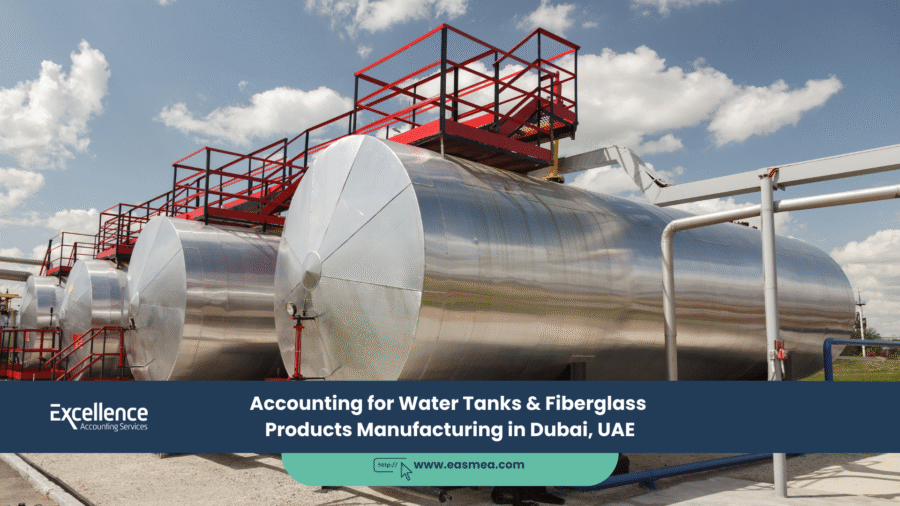Accounting for Water Tanks & Fiberglass Products Manufacturing in Dubai
The manufacturing of water tanks and fiberglass products is a cornerstone of Dubai’s construction and industrial infrastructure. This industry involves a complex production process, transforming raw materials like resins and fibers into durable finished goods. From an accounting perspective, this is a world of process costing, asset management, and intricate inventory valuation that is far more complex than a simple trading business.
- Accounting for Water Tanks & Fiberglass Products Manufacturing in Dubai
- The Financial Blueprint of a Manufacturing Business
- Core Accounting Principles for Fiberglass Manufacturing
- Navigating UAE Tax and Compliance
- What Excellence Accounting Services (EAS) Can Offer
- Frequently Asked Questions (FAQs)
- Build a Stronger Bottom Line.
Profitability in fiberglass manufacturing hinges on accurately tracking and allocating costs throughout the production cycle. How do you account for the depreciation of expensive, custom-made molds? How do you cost the raw materials consumed in each production batch? What is the true value of the finished water tanks sitting in your yard? Miscalculations in these areas can lead to incorrect product pricing, distorted profit margins, and significant compliance issues.
This guide provides a detailed blueprint for Accounting for Water Tanks & Fiberglass Products Manufacturing in Dubai. We will mold a clear understanding of the key financial challenges, from mold depreciation and raw material costing to finished goods valuation and UAE tax compliance.
Key Takeaways
- Molds are Key Assets: Production molds are high-value fixed assets. They must be capitalized and depreciated over their useful life, often using the “units of production” method.
- Track Raw Material Costs: The cost of resins, fibers, catalysts, and gelcoats are your primary direct material costs. These must be accurately tracked as they move into Work-in-Progress (WIP).
- Finished Goods Valuation is Complex: The value of a finished water tank includes direct materials, direct labor (workers’ wages), and an allocation of factory overhead (e.g., factory rent, machinery depreciation).
- Process Costing is the Standard: Unlike job costing, process costing is used to average costs over a large number of similar units produced in a continuous process.
- Tax Compliance is Mandatory: Your manufacturing business must adhere to 5% VAT on sales and the 9% UAE Corporate Tax on profits, making accurate cost accounting essential.
The Financial Blueprint of a Manufacturing Business
A fiberglass manufacturing plant is a conversion machine: it converts raw materials, labor, and overhead into valuable finished goods. The goal of manufacturing accounting is to precisely measure the cost of this conversion process. This allows for accurate pricing, effective cost control, and reliable financial reporting. Strategic oversight, often through CFO services, is vital to align production costs with overall business strategy.
Core Accounting Principles for Fiberglass Manufacturing
A strong financial structure requires mastering three key areas: mold depreciation, material costing, and inventory valuation.
1. Mold Depreciation
Molds are the heart of your production line, but they don’t last forever. Their cost must be allocated over their productive life.
- Capitalization: The significant cost of designing and creating a new mold is not an immediate expense. It is a fixed asset and must be capitalized on the balance sheet.
- Depreciation Method: While the straight-line method can be used, the Units of Production method is often more accurate. With this method, you estimate the total number of units a mold can produce in its lifetime. The depreciation expense for a period is then calculated based on how many units were actually produced in that period.
In manufacturing, a mold is a depreciating asset. Its cost must be systematically charged to the products it creates over its entire useful life.
2. Raw Material Costing (Resins, Fibers)
These are the direct materials that form your product.
- Inventory Tracking: You must have a robust system for tracking your inventory of raw materials like polyester resins, glass fibers, catalysts, and gelcoats.
- Work-in-Progress (WIP): As materials are requisitioned for production, their cost is transferred from the “Raw Materials Inventory” account to the “Work-in-Progress (WIP) Inventory” account.
- Costing Methods: You will use an inventory costing method like First-In, First-Out (FIFO) or Weighted-Average to determine the cost of the materials moving into WIP. Efficient management of supplier payments through an accounts payable system is crucial.
3. Finished Goods Inventory Valuation
The value of a finished water tank in your warehouse is more than just the cost of its raw materials.
- Absorption Costing: The final value of your finished goods must include three components:
- Direct Materials: The cost of the resins and fibers used.
- Direct Labor: The wages of the factory workers directly involved in making the product.
- Manufacturing Overhead: A share of all other factory costs, including factory rent, utilities, supervisor salaries, and depreciation of molds and machinery.
- Transfer to Finished Goods: Once a product is complete, its total cost (materials + labor + overhead) is transferred from the WIP Inventory account to the “Finished Goods Inventory” account.
- Cost of Goods Sold (COGS): When the finished product is sold, its value is finally transferred from Finished Goods Inventory to the “Cost of Goods Sold” on the income statement.
| Financial Item | Description | Accounting Treatment |
|---|---|---|
| Purchase of a New Mold | A new mold for a 1000-gallon tank costing AED 100,000. | Capitalize as a Fixed Asset. Depreciate over its useful life (e.g., based on units produced). |
| Resin Used in Production | AED 50,000 of resin is moved from the store to the factory floor. | Transfer the cost from “Raw Materials Inventory” to “Work-in-Progress (WIP) Inventory.” |
| Factory Electricity Bill | Your monthly DEWA bill for the manufacturing plant. | This is a manufacturing overhead cost. It is allocated to the WIP and becomes part of the product’s value. |
| Sale of a Water Tank | A finished tank is sold to a construction company. | Recognize “Sales Revenue.” Move the full cost of the tank from “Finished Goods Inventory” to “Cost of Goods Sold.” |
Navigating UAE Tax and Compliance
As a manufacturer, you have specific obligations under UAE tax law. Always refer to the official Federal Tax Authority (FTA) website for the latest rules.
VAT on Manufactured Goods
The sale of your finished products (water tanks, fiberglass panels, etc.) is subject to the standard 5% VAT rate. You must also account for the VAT you pay on your raw materials and other expenses, which you can typically recover through your VAT return filing.
UAE Corporate Tax
Your business’s net profit is subject to the 9% UAE Corporate Tax. Your inventory valuation methods and depreciation schedules have a direct and significant impact on your calculated profit. Using compliant and consistent accounting methods is a legal requirement. A thorough accounting review can ensure your costing methods are compliant before tax season.
What Excellence Accounting Services (EAS) Can Offer
Manufacturing accounting is a specialized field. At Excellence Accounting Services, we provide the expertise to manage the complexities of your production process.
- Cost Accounting Systems: We help you implement robust systems for process costing, tracking raw materials, and allocating overhead to determine your true product cost.
- Inventory Management: Our experts can assist in setting up inventory valuation systems (FIFO, Weighted-Average) and procedures for physical stock counts.
- Fixed Asset & Depreciation Management: We manage your fixed asset register, ensuring your high-value molds and machinery are depreciated correctly for both bookkeeping and tax purposes.
- Financial Reporting for Manufacturing: We prepare specialized reports, such as a Statement of Cost of Goods Manufactured, that provide deep insight into your operational efficiency.
- Comprehensive Tax Services: From VAT registration to complex Corporate Tax planning, we handle all aspects of your tax compliance.
Frequently Asked Questions (FAQs)
This inventory must be valued at the “lower of cost or net realizable value (NRV).” NRV is the estimated selling price minus any costs to sell. If you have to sell these defective tanks at a discount, you must write down their value on your books to this lower discounted price, recognizing a loss.
These are indirect labor costs. They are a component of “Manufacturing Overhead” and are allocated to the cost of the products being made, along with other factory costs like rent and utilities.
Job costing is used for unique, custom products (e.g., building a custom yacht). Process costing, which is used for fiberglass tanks, is for the mass production of identical items. It averages the total costs of a period over the total units produced in that period.
Normal, expected levels of waste (spoilage) are typically included in the manufacturing overhead rate and absorbed into the cost of the good units produced. Abnormal or excessive spoilage should be written off as a separate loss.
You must create a “warranty provision.” Based on past experience, you estimate the future cost of warranty claims (e.g., 1% of sales). This estimated amount is recorded as a “Warranty Expense” and a liability. When an actual warranty claim occurs, the cost of the repair or replacement is deducted from the provision liability.
This is a “selling expense,” not a manufacturing cost. Transportation-out, or freight-out, is recorded as an operating expense after the product is finished. COGS includes only the costs to make the product, not to deliver it.
Routine maintenance is expensed as “Repair & Maintenance.” A major repair that extends the life of the mold should be capitalized, adding to its book value and being depreciated over its new remaining life.
Accounting is central to this decision. A detailed capital budgeting analysis, including calculating the Net Present Value (NPV) and Internal Rate of Return (IRR) of the investment, is required. This involves projecting future cash flows, cost savings (e.g., from reduced labor), and the impact of depreciation on taxes. A feasibility study is essential.
This makes your choice of inventory costing method (FIFO vs. Weighted-Average) very important. In a period of rising prices, FIFO will result in a lower COGS and higher profit (as you are expensing older, cheaper materials first). Weighted-average will smooth out these fluctuations. The key is to choose a method and apply it consistently.
This is a specific financial report used by manufacturers. It details the flow of costs for a period, starting with beginning WIP inventory, adding direct materials, direct labor, and manufacturing overhead, and subtracting ending WIP inventory to arrive at the total Cost of Goods Manufactured. This final number is then used in the main income statement to calculate COGS.
Conclusion: Manufacturing Financial Strength
In the competitive world of fiberglass manufacturing, controlling costs is paramount. Your accounting system is not just for compliance; it is your primary tool for cost control and operational management. By implementing a sophisticated manufacturing accounting framework that accurately tracks material costs, labor, overhead, and asset depreciation, you can price your products competitively, maximize profitability, and build a business as durable as the products you create.
Build a Stronger Bottom Line.
Let Excellence Accounting Services provide the specialized cost accounting and financial reporting your manufacturing business needs to thrive in a competitive market.




